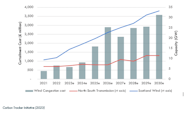
June 2023 saw UK climate change think tank Carbon Tracker issuing a sober report on Britain’senergy transition. The country had done well in increasing the amount of wind power on the grid,according to Carbon Tracker analyst Lorenzo Sani—but had not done so well with the grid itself.
As a result, Sani said, the electricity network was becoming increasingly congested and more and more renewable energy was going to waste because it could not be accommodated on the system.
“Investments in the electricity grid are not keeping up with the rapid growth of wind, resulting in recordlosses of green electricity and high costs for British consumers,” said Sani, adding that the power system “is currently not fit for purpose.”
Since 2021, Carbon Tracker’s research found, the UK had paid£1.5 billion in wind congestion costs at times when wind generation had to be turned away and gas plants closer to load centres were forced to fill in the gaps.

Meanwhile, the system curtailed enough wind power to keep a million households going for a year.
The situation is not likely to get better any time soon, Carbon Tracker found, with Scottish wind capacity expected to grow four times faster than the transmission infrastructure needed to take itsouth of the border.
The growing mismatch between generation and transmission in Scotland is expected to trigger afivefold increase in wind curtailment by 2030, with theUK throwing away enough renewable energy to supply 5 million homes.
“Wind congestion costs across the Scotland-England boundary are set to grow dramatically and could surpass £3.5 billion in 2030,” Carbon Tracker said.“This could result in a nearly £200increase inannual electricity bills for British households.”
The obvious way to avoid this problem is to build new transmission capacity. However, grid infrastructure takes an agonisingly long time to put in place.
According to the International Energy Agency, the average lead time for an overhead transmission line in Europe and the US between 2010 and 2021 was more than 10 years.
Even a low-voltage distribution line could take up to two years to build, and a large power transformer even longer to install. At those rates of progress, it is hard to see transmission infrastructure being built out in time to avert the 2030 bottleneck that Carbon Tracker foresees.
This point is recognised by Tim Chapelle, energy policy advisor at the Energy Systems Catapult, an independent, not-for-profit centre of excellence that bridges the gap between industry, government, academia and research to accelerate the transformation of the UK's energy system.
“Grid investment is important in our transition to net zero, but it is no silver bullet,” Chapelle said in response to the Carbon Tracker report.
“Whilst the knee-jerk answer to solving congestion is often purported to be grid expansion, in the same way that adding lanes to a motorway does not eliminate traffic, it's not possible or desirable to completely build out congestion on the grid.”
Instead, Chapelle’s suggestion is for the UK to embrace a concept called nodal or locational pricing.
The idea is simple: instead of everyone in the country paying the same amount for electricity wherever they are, energy users will pay less in places where generation is plentiful and cheap, and more where grid constraints make it harder for power to reach.
“The advantage of locational pricing is that it encourages generators and providers of flexibility to locate and operate assets—generation or storage—efficiently, taking account of the real physical constraints in the network,” said Chapelle.
“Introducing locational pricing could result in us better deploying low-carbon technologies in locations where the network is ripe for expansion and developing smarter flexible solutions in areas of constraint.”
Energy Systems Catapult has researched this topic and come to the conclusion that locational pricing could save bill payers around £30 billion up to 2035—savings that would be spread across all regions but would be proportionately greater in Scotland and the North of England.
The UK energy regulator Ofgem, meanwhile, kicked off an assessment of locational pricing in 2022. “These market designs are used in numerous jurisdictions around the world but would represent a significant change for Great Britain,” it noted.
“More accurate price signals, including prices that vary by time of day and location, have the potential to significantly reduce costs for consumers by incentivising the right demand and supply responses in the right places, at the right time, and making the best use of all available resources.”

Ofgem is expected to publish the findings of the assessment sometime this year. Chapelle is bullish on the prospects. “Without reform and the introduction of locational marginal pricing, we risk getting locked into a high-cost power system and facing public backlash against net zero,” he says.
Best Return for Investors
If the UK electricity grid does switch to locational pricing, how will that affect infrastructure investments? Clearly, the move would encourage new assets to be built in areas with high pricing potential, provided they are able to respond to price signals.
The range of options is limited, however. For example, Ofgem assumes nuclear, biomass and fossil fuel plants will not respond to locational pricing, while wind and solar deployment may be limited by resource availability, among other factors.
The assets that can best take advantage of locational pricing are those that are designed to offer flexibility, including demand response units, hydrogen clusters and of course energy storage.
Of these assets, energy storage offers the best immediate return for investors because demand response programmes and hydrogen clusters are still in their infancy.
Hydrogen production could take a while to ramp up and not all the facilities planned for the UK will use renewable energy to power electrolysis.
In contrast, battery storage plants can be built in a matter of months, as Pacific Green has proved with the Richborough Energy Park project. With locational pricing looking increasingly likely to soon become a feature of UK energy markets, now is the time to invest in such projects.
Publish date: 17 March, 2024